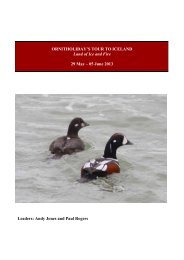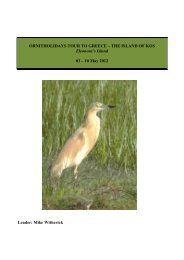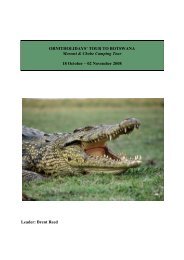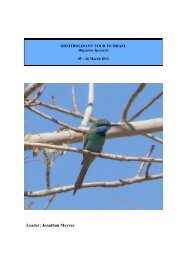Download 2014 Brochure (.pdf) - Ornitholidays
Download 2014 Brochure (.pdf) - Ornitholidays
Download 2014 Brochure (.pdf) - Ornitholidays
Create successful ePaper yourself
Turn your PDF publications into a flip-book with our unique Google optimized e-Paper software.
N E W Z E A L A N D<br />
New Zealand<br />
Kiwis, Kakas & Keas<br />
Sunday 02 November – Saturday 22 November <strong>2014</strong><br />
Leader: Mark Ayre<br />
<strong>2014</strong> Cost: £5,999 single room supplement £660<br />
he islands of New Zealand have been isolated for almost 80 million years, resulting in the evolution Milford<br />
T of a fascinating array of unique plants and wildlife. The islands’ avifauna evolved in the virtual Sound<br />
absence of mammals; consequently the birds occupied niches, which on other land areas were taken<br />
up by browsing mammals, squirrels and mice. It is these unique birds for which New Zealand is renowned<br />
– the flightless Kiwi, the endangered Takahe, and perhaps the most enthralling, the Kokako. The waters<br />
around New Zealand are home to a wide array of oceanic species; seven species of albatross and two-thirds<br />
of the world's penguins breed here. With the arrival of people came rats and stoats, and the island haven that<br />
Arthur’s Pass<br />
Franz Josef<br />
had served ground-dwelling vertebrates and invertebrates for so long was destroyed. Many species became extinct; many more continue to be at risk<br />
and are steadily declining in number. Despite this, the human impact has fortunately been less than in most other comparable countries. Nowhere<br />
else in the world is there such a rich diversity concentrated in so small an area. Over half of the flora and more than 70 bird species are endemic.<br />
They include some of the rarest in the world – Takahe, Kakapo, Black Stilt and the world's rarest penguins, the Yellow-eyed and the Fjordland.<br />
So, there is nothing quite like New Zealand – its birds, its scenic diversity and grandeur, its character, its equable climate and its friendly people.<br />
All of these make it one of the most pleasurable and rewarding countries to explore. <strong>Ornitholidays</strong> has travelled to New Zealand on over 22 previous<br />
occasions and our local guide for <strong>2014</strong> will be Mark Ayre, an ornithologist and naturalist, who has led our tours for many years. Our airfare will allow<br />
you to make various stopovers or extensions to this holiday.<br />
Lake<br />
Ohau<br />
Lake<br />
Te Anau<br />
Auckland<br />
Tongariro<br />
National Park<br />
Lake<br />
Taupo<br />
NEW ZEALAND<br />
Paraparaumu<br />
Picton<br />
Dunedin<br />
Stewart Island<br />
Kaikoura<br />
ITINERARY<br />
Days 1 to 4<br />
We leave London in the evening arriving into<br />
Auckland on the morning of the third day, where<br />
we are met by our guide and then travel a short<br />
distance to our hotel, where we stay for two<br />
nights. Here we can rest and freshen up after the<br />
long flight. We escape from the city to enjoy a<br />
gentle introduction to New Zealand birds. We shall<br />
watch Australian Gannets soaring towards their<br />
rock stack colonies, then stroll through the Kauri<br />
forests on the Waitakere Ranges. Here a range of<br />
introduced and native birds co-exist including<br />
Sulphur-crested Cockatoo, Eastern Rosella, New<br />
Zealand Pigeon and Grey Fantail. The next day we<br />
take a trip to Tiritiri Matangi, an island sanctuary in<br />
the Hauraki Gulf, just north of Auckland. Sailing by<br />
ferry to the island we may be passed by Australian<br />
Gannets, Parkinson’s and Cook’s Petrels, and<br />
Buller’s Shearwater. Many of New Zealand’s rare<br />
and endangered species now only remain on<br />
islands such as this, as the habitat can be<br />
protected from introduced predators such as rats<br />
and possums. Re-introduced rare species such<br />
as the Saddleback, Stitchbird, Whitehead and<br />
Red-fronted Parakeet occur here as well as the<br />
unique Takahe and Brown Teal.<br />
Day 5<br />
Within an hour’s drive southeast of Auckland lies<br />
Miranda Wildlife Sanctuary, a fine feeding<br />
ground for many wading birds, which migrate<br />
from the tundra of the arctic regions for the<br />
northern winter. Among the thousands of Bartailed<br />
Godwits on the shellbanks or silt flats, we<br />
may view Red Knot and South Island<br />
Oystercatchers, the rare endemic Wrybill, the<br />
endangered Red-breasted Dotterel, Far Eastern<br />
Curlew, Whimbrel, several sandpipers, Caspian<br />
and Little Terns and Sacred Kingfisher. Later this<br />
morning, we travel towards Lake Rotorua, where<br />
New Zealand Grebe, New Zealand Scaup and<br />
Little Black Cormorant are often feeding or<br />
roosting. Rotorua is situated in the central<br />
plateau of the North Island, a region of much<br />
geothermal activity. We stay overnight at Taupo.<br />
Day 6<br />
We have a dawn start this morning, in order to<br />
experience the haunting call of the endangered<br />
Kokako in its natural, misty rainforest<br />
environment. Pureora Forest Park contains one<br />
of the finest areas of podocarp forest in the<br />
country, as well as a large variety of native<br />
invertebrates, like the curious Peripatus, and<br />
numerous birds. We will have most of today to<br />
gain more insight into the nature and<br />
conservation of this special forest, and to enjoy<br />
the sounds of the New Zealand Kaka, Yellowfronted<br />
Parakeet, Tomtit, New Zealand Robin,<br />
Long-tailed Koel, New Zealand Falcon,<br />
Whitehead and Grey Gerygone. Later, our day<br />
winds up in Tongariro National Park where we<br />
stay overnight.<br />
Day 7<br />
This morning we head for the tributaries of the<br />
Wanganui River to look for the endangered Blue<br />
Duck. Later we may see the endemic Fernbird<br />
and Rifleman against spectacular mountain<br />
backdrops. Our journey continues southwards<br />
to Wellington, where we will embark on a ferry<br />
crossing to the South Island. Three hours,<br />
however, is at times not enough for all the<br />
Blue Duck<br />
90<br />
For a previous tour report or further information please call: 01794 519445








